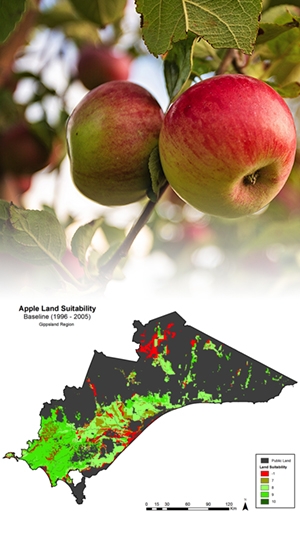Adapting to future landscapes
Research news
Anticipating and managing the effects of higher temperatures, less rainfall and more extreme weather conditions is vital for the future of Victoria’s agricultural sector.
Led by Associate Professor of Climate Change Adaption Robert Faggian, a team of researchers from Deakin University’s Centre for Regional and Rural Futures (CeRRF) has worked with organisations from Gippsland, the Southern Grampians, the Goulburn Broken region and a group of councils including Golden Plains and Moorabool, to develop “practical and concrete” resources to help the agricultural sector and local government adapt to climate change and plan for the future.
The CeRRF team works closely with farmers to develop models that predict the impact of climate change on crop yields to 2070. Interactive maps allows users to see what the yield for a particular commodity may be and the geographical areas where yield is predicted to be high or low.
“It’s an approach that allows the team to incorporate the expert knowledge of farmers and locals,” Assoc Prof Faggian says.
“We apply an objective scientific approach to match biophysical factors across the landscape with agricultural commodities – our models use topography, climate and soil parameters to create preliminary maps that farmers then review.
“We have them assess the relative importance of each biophysical parameter by applying a weighting, according to their knowledge of the local area and their expertise within that particular farming system. It’s an iterative, communication intensive process, which results in a product that typically generates a high level of client satisfaction.
“Because the models come from their knowledge and information, they accept the resultant yield maps that correspond to the present. We then insert climate projections into the models to generate yield maps for a range of future climate scenarios.”
Assoc Prof Faggian says this information could be used by local and state government to inform and generate strategic regional development plans and pinpoint locations where planning issues will need to be carefully managed and where new areas of agriculture may need to be supported.
The team’s work in Gippsland produced information used to inform the Gippsland Regional Growth Plan, while the Southern Grampians Shire Council has used the research results from that region to support existing farmers in adapting to changing conditions and to attract new agricultural producers to the area.
In the Goulburn Broken region, often referred to as “Victoria’s food bowl,” the team is working on the “Climate Smart Agricultural Development Project,” developed by the Goulburn Broken Green House Alliance in partnership with Deakin and seven local councils, to investigate how climate change in conjunction with local soil types might affect production of 17 of the region’s most important commodities including fruit, cereals, pasture and vegetables.
The most recent collaboration is the Central Highlands-based “Future Landscapes” project, a partnership between the Hepburn Shire Council, Golden Plains Shire, Moorabool Council, Pyrenees Shire Council, City of Ballarat and Cultivate Agribusiness Central Highlands Inc. Following a competitive tender process, CeRRF and Deakin’s Centre for Integrative Ecology (CIE) were appointed to deliver the project.
“The Future Landscapes project is unique in that it brings together biodiversity and agriculture in the same climate change impact project,” Assoc Prof Faggian says.
“We’re modelling the impact of climate change on certain crops and on different ecological systems to understand how to better manage land-use change to achieve multiple socio-economic and environmental benefits.
“This kind of information is vital to the planning process for councils and how they allocate resources for conservation activities. In a climate-changed future, some native vegetation systems may decline or improve, depending on their geographical location.
“Our modelling may help to prioritise the allocation of limited conservation budgets towards those areas where native vegetation has the best chance to thrive.”
Assoc Prof Faggian says farmers are already observing the southward shift of climate and that those who want to remain in a particular farming system are following the climate in order to do so.
“It is possible, and entirely appropriate in some contexts, to keep farming in a particular location by making a series of incremental adaptations to climate change. But in other instances, it will be necessary to implement a more substantial ‘transformational’ adaptation, like moving to a new geographical location or shifting to a new farming system entirely,” he says.
“Climate change is a reality and the impacts are already being felt in the agricultural sector. However, having objective, scientifically robust information allows farmers and regions to plan strategically for climate change, and therefore avoid some of the impacts, and even capitalise on, the opportunities that it presents.”
Share this story
 Apple land suitability graph. Baseline (1996-2005)Gippsland Region
Apple land suitability graph. Baseline (1996-2005)Gippsland Region
